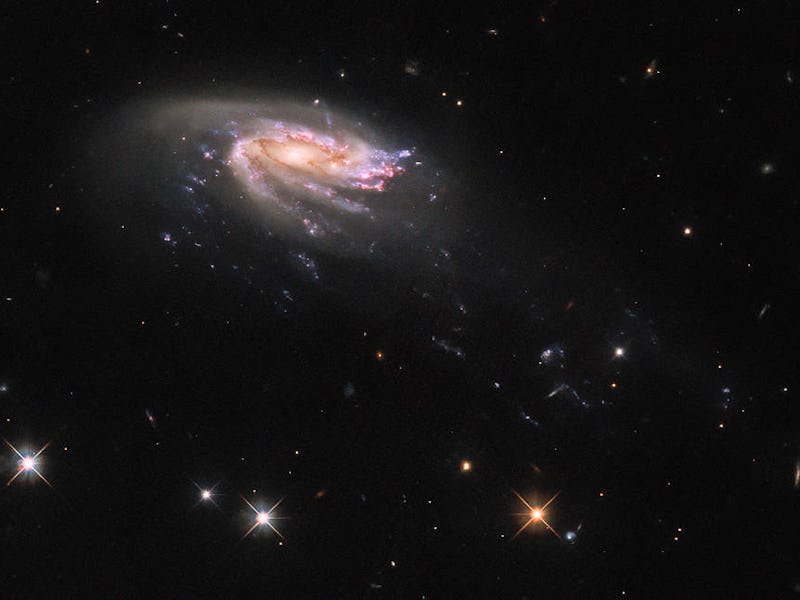A “Jellyfish” Galaxy Survives Turbulent Cosmic Seas in New Hubble Image
When the Hubble Space Telescope peered into constellation Aquarius, it glimpsed at a "jellyfish" galaxy.

Humans have been filling the night sky with animals for millennia, from the bear in Ursa Major, to the swan in Cygnus. But modern astronomers do it too. Take the case of jellyfish galaxy, JO206.
Unlike constellations, which act like roadmaps to tracking stars and orienting a location in space, the jellyfish descriptor given to a galaxy about 700 million light-years away from Earth is practical in a different way. When the Hubble Space Telescope took a sideways view of this object, called JO206, astronomers could see that behind the galaxy there were cosmic tentacles.
And in a surprising twist, they seem to be filled with stars. They’re much farther away than the three bright stars at the bottom of the image. Those are nestled in the Milky Way when looking out in the direction of the constellation Aquarius. But the haze that surrounds JO206 has stars too. These have miraculously survived the whims of intergalactic space.
This image from the NASA/ESA Hubble Space Telescope shows the “jellyfish” galaxy JO206 and three interloper stars much closer to Earth. The galaxy is located 700 million light-years from Earth.
Without the protection of the galaxy itself, the gas and dust in these tentacles are at the mercy of the fourth state of matter, plasma. This charged material was thought to be a hazard to stellar formation, which would be unfortunate since it is pervasive in the space between galaxies of a group, called a cluster. The European Space Agency (ESA) describes the scenario playing out in the Hubble image in a new statement. NASA, which operates Hubble with ESA, shared the description on its website on Friday.
The tentacles are a product of this wild environment. As a jellyfish galaxy moves through the cluster, it drags against the choppy plasma sea.
“The tendrils of jellyfish galaxies are formed by the interaction between galaxies and the intra-cluster medium, a tenuous superheated plasma that pervades galaxy clusters. As galaxies move through galaxy clusters, they ram into the intracluster medium, which strips gas from the galaxies and draws it into the long tendrils of star formation,” space agency officials write in the image description.
“The tentacles of jellyfish galaxies give astronomers a unique opportunity to study star formation under extreme conditions, far from the influence of the galaxy’s main disk,” they add.
When astronomers looked at Hubble’s observations, they saw “no striking differences” between star formation inside the galaxies themselves versus the tentacles. NASA says this “suggests the environment of newly formed stars has only a minor influence on their formation.”
Hubble is a 33-year-old heritage observatory. It continues to work alongside other telescopes, like its new partner in space, the James Webb Space Telescope. For now, Hubble is still going strong, supporting astronomers as they study the stars of the universe.
This article was originally published on